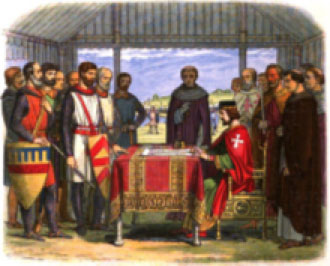Following a revolt by the English nobility against his rule, King John put his royal seal on the Magna Carta, or “Great Charter” on the 15 June in 1215. The document, essentially a peace treaty between John and his barons, guaranteed that the king would respect feudal rights and privileges, uphold the freedom of the church, and maintain the nation’s laws. Although more a reactionary than a progressive document in its day, the Magna Carta was a cornerstone in the development of democratic England by later generations.
The document drawn up for John in June 1215, forced the king to make specific guarantees of the rights and privileges of his barons and the freedom of the church. On 15 June 1215, John met the barons at Runnymede on the Thames and set his seal to the Articles of the Barons, which after minor revision was formally issued as the Magna Carta. The charter consisted of a preamble and 63 clauses and dealt mainly with feudal concerns that had little impact outside thirteenth century England. However, the document was remarkable in that it implied there were laws that the king was bound to observe, thus precluding any future claim to absolutism by the English monarch. In immediate terms however, the Magna Carta was a failure – civil war broke out the same year, and John ignored his obligations under the charter. Upon his death in 1216, however, the Magna Carta was reissued with some changes by his son, King Henry III, and then reissued again in 1217.
That year, the rebellious barons were defeated by the king’s forces. In 1225, Henry III voluntarily reissued the Magna Carta a third time, and it formally entered English statute law. The Magna Carta has been subject to a great deal of historical exaggeration; it did not establish Parliament, as some have claimed, nor more than vaguely allude to the liberal democratic ideals of later centuries. However, as a symbol of the sovereignty of the rule of law, it was of fundamental importance to the constitutional development of England. Four original copies of the Magna Carta of 1215 exist today: one in Lincoln Cathedral, one in Salisbury Cathedral, and two in the British Museum.

